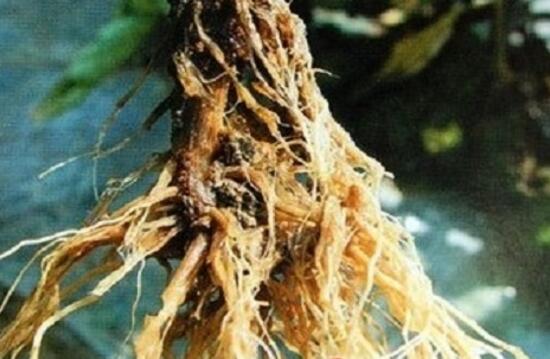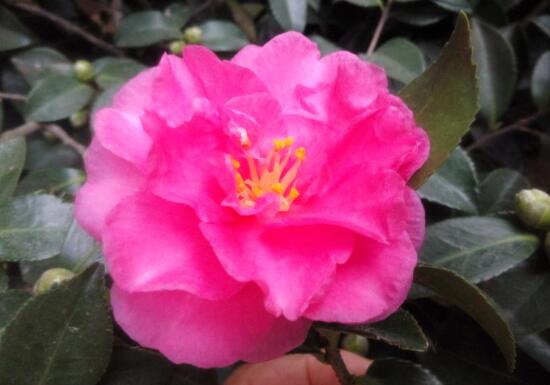What's wrong with the rotten roots of Camellia oleifera? overwatering, fertilizing and fertilizing too often / potted soil is the key.
Tea plum, with its beautiful leaves, bright and beautiful flowers, is welcomed and loved by the broad masses of people, and is kept at home by many people. However, in the process of breeding, many flower friends often encounter rotten roots, that tea plum rotten roots is how to return a responsibility? How to treat the rotten root of tea plum? In this regard, it is up to the editor to solve everyone's doubts.
First, the tea plum rotten root is how to return a responsibility, look at the performance to find the cause

The root of tea plum is fleshy root, if we do not raise it according to the culture method of tea plum, it is easy to have the symptom of rotten root, how is the rotten root of tea plum going on? In this regard, let's first take a look at the symptoms and causes of tea plum rotten roots, and then take a look at how to treat tea plum rotten roots.
(1) the symptoms and causes of rotting roots of tea plum.
1. Soil alkali / flowerpot is not suitable.
Tea plum likes loose, fertile and slightly acidic soil with good drainage. If the pot soil is not selected properly, tea plum is easy to rot its roots, which mainly includes two reasons: soil and basin change.
① soil: according to the growth habits of Camellia oleifera, if the soil is alkaline or not loose enough, it is easy to have root rot symptoms. Therefore, when choosing basin soil, we should not choose high alkaline ones. In addition, the soil also needs to be loose and breathable and rich in humus, so as to reduce the occurrence of rotting roots.
② flowerpot: in addition to the rotting roots of tea plum caused by the soil, there may also be something wrong with the flowerpot. Generally grow tea plum, tile basin is better, followed by purple sand basin, porcelain basin is not suitable. If the size of the flowerpot is not suitable for the root extension of tea plum, it is easy to rot.
2. Excessive or concentrated fertilization
Tea plum does not have high requirements for fertilizer, once we apply too much fertilizer too frequently or too thick, it may lead to rotten roots, so it is best to use thin fertilizer to fertilize tea plum. In addition, winter is the dormant period of tea plum, it is generally necessary to stop fertilization.
3. Overwatering
Tea plum likes a humid environment, so it should be watered frequently, but once it is watered too much, it may lead to rotting roots. Therefore, when we are watering, we must pay attention to watering when the surface of the basin soil becomes dry, not too much water, or else the roots will rot. In addition, if watering is needed in winter, the water temperature should not be too low.
4. The humidity is too high
The root rot of tea plum may be caused by too much humidity in addition to too much watering. In the tea plum growing environment, if the ventilation is not false, coupled with high air humidity, it will cause rotten roots.
(2) how to treat the rotten root of tea plum and change the pot soil / drug treatment
1. Change the basin and change the soil
How to treat the rotten root of tea plum, the simplest thing is to change the pot and change the soil. Specific operation: remove the tea plum from the basin, then cut off the rotten roots and clean the roots. After that, the root of the disease is disinfected and soaked in 0.1% murine 0.2% potassium permanganate solution for 1 minute. After the wound is dried, it can be put on the basin. Tea plum on the basin, should first be placed in a cool place to maintain for a period of time, after the tea plum slow root can be normal maintenance.
2. Drug therapy
Tea plum rotten roots can be treated with appropriate anthers, if it is diseases and insect pests, you can according to the tea plum pest control requirements, the specific front has a special introduction, there is no more here.
Generally speaking, in summer, tea plum should be watered more, but can not accumulate water; in the growth process of tea plum, it needs fertilizer, but not much, which requires us to master this degree, as long as we really master it, raising tea plum will become much easier. With regard to the causes and treatment methods of rotting roots of tea plum, the editor has introduced this, hoping to bring help to everyone.
What's wrong with the rotting roots of tea plum?
The reason for the rotting Root of Tea Plum-- potted soil
Improper selection of potted soil, tea plum is very easy to rot roots, which mainly includes two reasons, soil and changing pots.
If there is something wrong with the soil, it includes two reasons, one is that the acidity and alkalinity of the soil is not suitable, and the other is that the soil is not loose and permeable enough. Camellia oleifera likes acidic soil, so when choosing potted soil, do not choose highly alkaline soil. In addition, the soil also needs to be loose and breathable, rich in humus, more suitable mountain soil, can add a certain amount of pine needles or river sand, which can be conducive to the growth of tea plum roots and reduce the occurrence of rotting roots.
If there is something wrong with the flowerpot, it is necessary to find the cause in terms of texture and size. Generally grow tea plum, tile basin is better, followed by purple sand basin, porcelain basin is not suitable. In terms of size, it is mainly to ensure that the plant of tea plum can grow well and facilitate the extension of the root system.
The reason for the rotting Root of Tea Plum-- fertilization
Fertilization leads to rotting roots of tea plum, mainly because fertilization is too frequent and too strong. The best way to fertilize tea plum is to use thin fertilizer, which can be divided into three growth stages. Nitrogen fertilizer can promote the good growth of Chung shoot in March and April. Phosphate fertilizer is the main fertilizer in May and June, which can make the flowers blossom brightly. The compound fertilizer of nitrogen, phosphorus and potassium is the best in September and October. Winter is the dormant period of tea plum, generally stop fertilizing.
Therefore, in the fertilization, in addition to ensure that tea plum nutrients are adequate, but also need to pay attention to a degree, in case the fertilizer is too thick and burning roots, rotting roots.
The reason for the rotting Root of Tea Plum-watering
In fact, the root rot of tea plum is mostly caused by too much watering. Tea plum needs a lot of watering when it is growing vigorously, but there is still a certain degree, so watering is best carried out according to the dry and wet condition of the potted soil, which is related to the climate, the size and texture of the flowerpot, the growth environment and so on. Basically, when the surface of the basin soil dries, it should be watered, not too much, or the roots will rot. In addition, if watering is needed in winter, the water temperature should not be too low.
An Analysis of the specific causes of the rotten Roots of Tea Plum
The root of tea plum is fleshy root, which is very easy to rot in the case of improper management. If you have the same problem with tea plum, hurry up to take a specific look at the cause of the rotting root of tea plum.
The reason for the rotting Root of Tea Plum-- potted soil
Improper selection of potted soil, tea plum is very easy to rot roots, which mainly includes two reasons, soil and changing pots.
If there is something wrong with the soil, it includes two reasons, one is that the acidity and alkalinity of the soil is not suitable, and the other is that the soil is not loose and permeable enough. Camellia oleifera likes acidic soil, so when choosing potted soil, do not choose highly alkaline soil. In addition, the soil also needs to be loose and breathable, rich in humus, more suitable mountain soil, can add a certain amount of pine needles or river sand, which can be conducive to the growth of tea plum roots and reduce the occurrence of rotting roots.
If there is something wrong with the flowerpot, it is necessary to find the cause in terms of texture and size. Generally grow tea plum, tile basin is better, followed by purple sand basin, porcelain basin is not suitable. In terms of size, it is mainly to ensure that the plant of tea plum can grow well and facilitate the extension of the root system.
The reason for the rotting Root of Tea Plum-- fertilization
Fertilization leads to rotting roots of tea plum, mainly because fertilization is too frequent and too strong. The best way to fertilize tea plum is to use thin fertilizer, which can be divided into three growth stages. Nitrogen fertilizer can promote the good growth of Chung shoot in March and April. Phosphate fertilizer is the main fertilizer in May and June, which can make the flowers blossom brightly. The compound fertilizer of nitrogen, phosphorus and potassium is the best in September and October. Winter is the dormant period of tea plum, generally stop fertilizing.
Therefore, in the fertilization, in addition to ensure that tea plum nutrients are adequate, but also need to pay attention to a degree, in case the fertilizer is too thick and burning roots, rotting roots.
The reason for the rotting Root of Tea Plum-watering
In fact, the root rot of tea plum is mostly caused by too much watering. Tea plum needs a lot of watering when it is growing vigorously, but there is still a certain degree, so watering is best carried out according to the dry and wet condition of the potted soil, which is related to the climate, the size and texture of the flowerpot, the growth environment and so on. Basically, when the surface of the basin soil dries, it should be watered, not too much, or the roots will rot. In addition, if watering is needed in winter, the water temperature should not be too low.
- Prev

What to do if the tea plum leaves are gone? watering frequently to prevent frost damage / pest control is the key.
Tea plum, many people should know, it combines tea plum and beautiful advantages, is a very beautiful flower. However, because many people do not raise tea plum according to the culture method, there are all kinds of problems, such as tea plum leaves yellowing, falling leaves and so on. What if the tea plum leaves fall out?
- Next

The breeding method of Rhizoma Rehmanniae
The breeding method of Rhizoma Rehmanniae
Related
- Fuxing push coffee new agricultural production and marketing class: lack of small-scale processing plants
- Jujube rice field leisure farm deep ploughing Yilan for five years to create a space for organic food and play
- Nongyu Farm-A trial of organic papaya for brave women with advanced technology
- Four points for attention in the prevention and control of diseases and insect pests of edible fungi
- How to add nutrient solution to Edible Fungi
- Is there any good way to control edible fungus mites?
- Open Inoculation Technology of Edible Fungi
- Is there any clever way to use fertilizer for edible fungus in winter?
- What agents are used to kill the pathogens of edible fungi in the mushroom shed?
- Rapid drying of Edible Fungi

